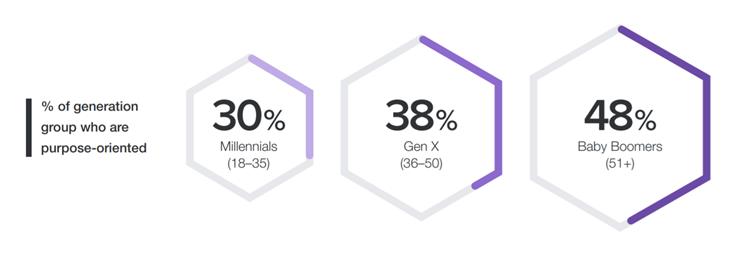The 15th Anniversary Customer Contact West: A Frost & Sullivan Executive MindXchange in Huntington Beach, California, was a meeting of innovative, enthusiastic, collaborative, and analytical minds. This year, the main challenges discussed by contact center leaders were:
- Improving employee engagement and retention
- Finding the right balance between excellent CX (customer experience) and automation
- Moving the company’s vision beyond revenue and profit generation to one that will move us all towards a better world
There were so many sessions with loads of information to process. This insight gives you an analysis of the top 5 takeaways in 2019:
- Employee engagement is the key to success
- Take time to teach your ro/co/chat bots
- Dig deep – find the root causes of challenges
- Trust will be a key factor as automation increases
- Don’t ever forget the Voice of the Customer
1. Why is Employee Engagement Critical?
Demographics are Changing Quickly
Frost & Sullivan has found the following through extensive research in the past year:
- The demographics of the contact center have changed in the past decade. The contact center workforce draws from the millennial and younger generations, which favor a more flexible workplace environment with work/life balance. An increasing number want to work from home
- The gig economy is made up of not just the younger generation, but of the older generation as well. It can include retirees who need a bit of extra cash or are bored. Mothers (or fathers!) may also be part of this economy – they want to work a few hours a week and still be home when the kids are back from school. This dynamic workforce creates uncertainty for your company
- In the “it’s all about me” world we live in today, people actually want to like their jobs. Keeping them engaged will be critical for employee retention
- People are worried that new technologies will replace them. Thus far, we are finding this to be fiction
So what can be done in this fast changing decade?
Hire the Right People
Employing people that are a good fit for your company and its goals is an important first step. Of course, you can’t fire everyone and rehire next week. But you can start by rethinking your hiring process. Are your supervisors involved? Do the interviewees feel welcome? Do you ask questions that will help you better understand what drives them?
Regan Heckethorn from Allegiant, an ultra – low cost carrier, gave an insightful presentation on Hiring for Staying Power & Brand Fit. She said, “We recognized that the company brand is the mirror image of your workforce.” She suggests you start with making a great first impression. Pleasant décor, welcoming behavior, and a positive attitude set the stage for selling the job to the employee. Supervisors are the people in the company who are most familiar with the core competencies and behavior needed to perform well; make sure they are part of the hiring process. Look for traits that will ensure that the candidate will be a good fit by asking deeper questions about the previous jobs they’ve held and their personal interests. Make the interview fun! You’ll get a lot more out of the interview, and the candidate will be more interested in taking the job. As a result of this hiring makeover, Allegiant’s NPS performance grew significantly year over year from 2016 to 2019.
Some key core competencies to look for may be:
- Communication capabilities
- Flexibility
- Teamwork
- Service orientation
- Initiative and creativity
- Problem solver
- Resilience
- Continuous improvement
- Ability to leverage technology
Provide Purpose to Engage Them
Joel Kell, Senior Director of Service Operations from a company called Elevate, said that it’s important to get the front line involved in processes. Ensure their buy-in to make the employee experience more meaningful so that it’s not an “us versus them” workplace environment. He says, “Getting agents involved creates a bond and elevates products.”
Derek Carder, Vice President Customer Experience and Technical Operations at Geotab, said that trust is not just external with customers, but also internal with employees. “In an atmosphere of constant change, build in the ‘why’ and engage teams in their role to help keep up with changes. I think of team-driven employee engagement. Employees really enjoyed being content creators; they were fired up.”
Paul Epstein, who is an Executive Coach & Organization Consultant at Chapman & Co. Leadership Institute, presented on the importance of employees being purpose-oriented. When employees are purpose-oriented, they prioritize meaning and career fulfillment over money and status.
He cited some data from LinkedIn. LinkedIn conducted a large survey on this topic using its large subscriber base and found that while 42% of no-purpose led companies showed a drop in revenue, 85% of purpose-led companies saw positive growth. Clearly, having a purpose has a huge impact on businesses.
The top 5 purpose-oriented countries were Sweden, Germany, Netherlands, Belgium, and Poland. The biggest surprise was the finding that the older the generation, the more purpose-oriented they felt. I had presented at the event on how Millennials are furious about what we have done to the world and will make change. Looks like so will the rest of us.

Source: LinkedIn
Most important of all, purpose-driven professionals are 47% more likely to be promoters of their company and 30% are more likely to be high performers. Having purpose makes a difference.
Emotional Connection
In a world of digital communications, social media, and one that is moving towards robotics and artificial intelligence, human nature requires us to seek emotional connections. It’s in our DNA. Root Incorporated’s Gary Magenta, Chief Change Architect and Senior Vice President and Bridget Stallkamp, Vice President, believe that the reason change fails is people; and you need to have an emotional connection to change anything in an organization. They suggested connecting the front line to the why and how their work has an impact on the organization.
Environment
Advancements in headsets, sound walls, and décor can reduce stress, improve well-being, and cut down on absenteeism and attrition.
Raquel Macarthy, Head of Customer Experience at Replacements, asked companies to spread the love. She noted, “The call center was drab, low-energy when I first came. Now we put up decor, we surprise them with food, and bring energy. Have some fun and show appreciation since they have to be here 40 hours a week.”
Agent Training
We also discussed how important it is to keep agents learning future-proof skills (ones that can’t be taken over with automation). This means allowing for more non-scripted and empowered customer care handling.
Gamification can dramatically increase engagement by motivating agents to change behavior, participate in team-building and collaboration. Story telling helps with context while role playing helps employees understand real-life situations. Empowering agents with updated desktops and AI helps them to have the information they need to handle queries quickly and still build customer relationships.
Execs Take Calls!
We heard numerous times that bringing in CEOs, CIOs, and other top level executives to take calls in a contact center goes a long way in getting “asks” approved and improving morale.
Derek Carder said, “I told my boss he should take phone calls. It became a big event, with customer, service, auditing, and marketing there. It was informative!” From his experiment, he identified and changed processes so that agents can access more data. Raquel Macarthy said, “We take them [executives] on an all-day experience of everything the agents see/touch/feel, and then identify areas of mistakes that the developers made.”
2. CX Technologies – Teach and Repeat
Which technologies were most talked about at the event?
Deliver Dynamic Customer Engagement
Investing in technologies that allow agents to deal effectively with these increasingly demanding and quite knowledgeable customers will allow you to gain a competitive edge. These solutions can give customers what they want:
- Convenience- Can I get my information right away? With my channel of choice?
- Competency- Is this the right agent for this interaction? Do they have the right information?
- Personalization- Do they know my history? Do they you know me and my preferences?
- Proactive care- Can you anticipate my needs? Can you add value to the interaction before even I know what I want or need?
Chatbots were covered in many sessions. Finding a balance between automating and delivering the best CX was the key issue tackled. One example was provided by Aarde Cosseboom, Senior Director of GMS Technology and Product at TechStyle Fashion Group, which handles customers for companies such as Fabletics, Fabkids, JustFab, and ShoeDazzle.
The company has incorporated a number of features to address challenges such as offsetting volume spikes associated with subscription billing and reducing the number of calls that are not revenue-generating to agents.
The company opted to omit email as a channel since the demographic it targets comes through social media.
The TechStyle AI-powered Virtual Agent automates conversations handled by live agents today over voice, chat, and text. This provides the company with automated functionalities such as natural language, routing, order status, account management, billing, support and chat. AI retains the info gathered before passing on to the live agent so that the agent can pick up from where they left off rather than having to repeat the information.
A couple of interesting issues they uncovered about chat were particularly interesting:
- Twitter responses to chat box: they work faster than agents!
- The number of chats increased after this solution was launched – this is because the solution makes it easier to call and get the information they need using self-service while they drive
- Sometimes bots can’t differentiate between real inappropriate words and actual products that are for sale (such as Rihanna’s company, Savage X Fenty, which sells undergarments and generated a lot of calls with vulgar words). AI has to be taught which words are related to products, and which ones, ahem, are not! I definitely got a kick out of this example
The chatbot implementation enabled the company to save over $1 million and achieve a 92% member satisfaction score. Don’t tell anyone, but chatbots can be faster than people in delivering what customers need. Plus, they don’t call in sick.
On the other hand, Uber had a completely different experience. The company grew exponentially over the past few years, making it difficult to plan how to handle calls and improve CX. Kal Kuchimanchi, Director of Global Strategy and Central Operations at Uber, said that this resulted in scripts that were so rigid that the agents were believed to be robots! I heard this a few a times – scripts can result in a poor customer experience. My most recent call with a Bloomingdales agent was scripted in a way that the agent could not solve a problem; getting to the supervisor cost me 20 minutes in a queue. I decided to hang up and try another agent instead, who quickly resolved my problem. Sigh. That doesn’t mean scripts don’t have their place in customer care, but whenever possible, allow the agents to go off-script.
Sage advice – start small, work out as many kinks as you can with your automation before you go live with all of your products and services. Also, be sure you know your budget. The worse thing that can happen is that you run out of money mid-project. Half an implementation will not do much for you.
3. Dig Deep to Learn the Root Cause
This applies to customer issues and employee challenges. Identifying the root cause of the CX difficulties provides you with an opportunity to solve the problems.
Aisha Ponds, Director of Stakeholder Expectations at Blue Cross Blue Shield of North America, gave some great advice on why root cause mapping is important. She says it allows for a deeper analysis of customer experiences by understanding the trigger points and researching escalations from the beginning of the customer contact point to the problem resolution. Analyze the people, processes and tools. Incorporate feedback from customers, vendors, employees, and anyone else involved in the process. Find the gaps between your goals for this customer and what was delivered. Then, create correction plans and follow up on results.
Uber’s Kuchimanchi also talked about spending time to understand the root cause. Going through this process enabled Uber to align its KPIs, enable employees to speak the same language beyond KPIs, find champions, and celebrate the small and big wins.
4. Listen to the Voice of the Customer
While the importance of employee satisfaction is becoming equal with customer experience, we always have to stay ahead of what customers want in order to deliver CX better than the competition. Making customers the pillars of your corporate culture is still true. Some say employees should come first and if they’re happy, customers will follow. However, if we don’t understand the changing dynamics in customer demands, employees will not be able to service them well. It’s a chicken and egg kind of thing. What does providing excellent customer experience mean today? What do customers really want? Some deliverables:
- To use whatever device they feel like at any given moment
- To use automated solutions or access a human, or both, or whatever they feel like at any given moment
- They want it personalized, because these days, “it’s all about me”
- They want it quickly
- They really want the agent to know more than them, which is tougher these days with all of the social media and big data available to them
- And speaking of social media, customers have power and they know it
- If you fail to deliver they will shop around, and if need be, switch to competitors to get the best CXs. They are fickle!
Teddy Burress, Senior Consultant, Customer Experience at Nationwide, says “every role across the company has a ripple-effect on customer experience; non-customer facing roles are value creators, customer facing roles are value deliverers.”
Her company is obsessed with the customer, rather than the competition. She talked about the value that collaboration brings to any organization.
5. Build Trust with Customers and Employees
Consumers Will Always Worry about Security and Privacy
In this digital world, security threats will never fade. Kandy White, Senior Vice President of Operations at Altisource, cited a Saleforce data point – 92% [of customers] say their trust in a company makes them more likely to buy more products and services.
A study conducted by Harvard Business Review found that the Household, Beauty, and Personal Care industry is found to be the most trustworthy, while Healthcare, Government, and Telecom are at the bottom of the pack.
Being transparent is essential to ensure customers trust your brand enough to share data. White suggested that organizations ensure their customers:
- Understand how the data will be used to provide value to them
- Receive better, personalized experiences as a result
- Know that the company will control what is collected, shared, and used
- Believe that the company is committed to protecting their data and concerned with a higher purpose than profit alone
Fun fact: Millennials and Gen z are more likely to share data to get recommendations and customized experiences.
Employees Who Trust their Companies Will Perform Better
Paul Epstein also discussed why trust is important for employees. A great example is the difference between requiring approvals and making people accountable for their decisions. Another great thought: having an environment where everyone goes about their business as usual when leaders are around, rather than becoming nervous. Lastly, people who need help get help because vulnerability is better than not admitting they don’t know. All this can empower agents.
Create Cross-Functional Teams to Break Down Silos
This was advice I heard in several sessions. Everyone in the organization should be part of the processes and decisions to improve customer experience, whether they are creators or deliverers.
Burress also asked companies to “Bring together the organization, eliminate barriers, and tear down organizational silos with cross-functional teams to collaboratively partner to set priorities, operationalize the customer experience and optimize growth and efficiency opportunities. “ Here’s a valuable African Proverb she shared with us –
If you want to go fast, go alone. If you want to go far, go together.
All of this requires trusting each other within the organization. If teams are not created across functions, they will fight for budgets and worry about job security. A cross-functional team, on the other hand, can give your company the diversity it needs to see from a 360 degree perspective.
The Last Word
I would like to leave you with the following pieces of advice I heard as I walked through different sessions throughout the event.
- Hit home runs not singles; to create real value you have to big. Making a visible and obvious changes is good for your team
- All Stars Only! We know your best people are always busy, but if you put your best people on these transformative tasks, they’ll do the best job
- Be open. Bring everyone into the transformation process so they feel comfortable about the implementation
- Invest time to train bots. They don’t know the language of different industries. AI needs to be monitored after implementation and keep getting tweaked
- Check your policies. If your policies are not good, then the customers are not angry with the agents they are yelling at, they’re mad at your system
- Inform agents of the end goal. Help them understand their purpose
Stay connected with Frost & Sullivan –we’ll work together to find opportunities in the next decade.



